
bbartlog - 24-6-2011 at 13:01
I have a multitude of mulberry trees growing on my property - not the tastier Morus rubra but the relatively bland and therefore not very
useful (as a food) Morus alba, the white mulberry (or some hybrid that is far closer to the white than the red).
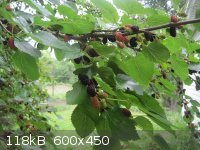
While trying to find some use for them I ran across the following paper describing the use of an extract as a pH indicator for titration:
http://sphinxsai.com/CTVOL3/CT=26,%20K%20S%20PATHADE,%20(549-551).pdf
Interesting enough (though hardly a major effort, their work seems like a high school AP Chem project). But lacking in pictures as well as any
suggestion as to whether the indicator could be used in small enough amounts to be useful.
Anyway, I decided to reproduce their work. I harvested 110g of ripe mulberries, put them in a 500ml beaker, mashed them crudely, and added 170g of
methanol and 3g of 31% HCl. Then I covered the beaker with a watch glass and left the mixture to steep for four days. The mixture was then filtered
through a coffee filter.
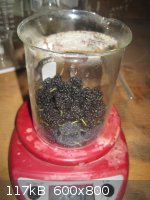
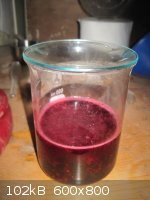
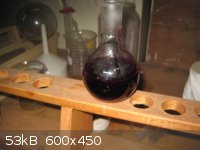
Adding 200 microliters of the resulting liquid to 50ml of 1% HCl and 50ml of ~10% ammonia gave the results shown in the picture. Much less would
probably start to be hard to read as an indicator, though perhaps the solution could be made more concentrated.
The indicator is oxidized to colorlessness by any of H2O2, NaOCl, or longish (1 hour) exposure to air in alkaline solution. In acid solution only
NaOCl seems to oxidize it (at least in a small amount of time).
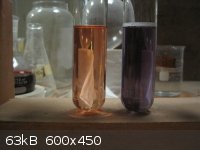
I would note in passing....
The WiZard is In - 24-6-2011 at 13:19
A. L. Cohn
Indicators and Test-Papers : Their Source, Preparation,
Application, and Tests for Sensitiveness
John Wiley & Sons
1899
I own an original copy - you can DL your's from Google.com/books
Nothing on mulberry paper, however, you may find the book interesting.
White Yeti - 29-7-2011 at 08:10
Interresting. Mulberries have exceptionally high anthocyanin content. As do red cabbage leaves and raspberries. I just so happen to have loads of wild
raspberries and blackberries growing on the sides of my yard. I might give this a try with raspberries : )
